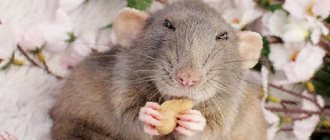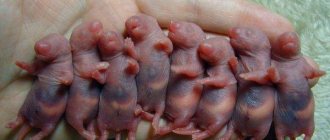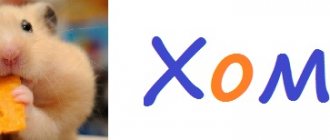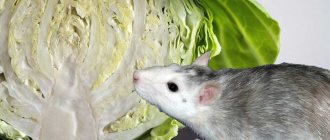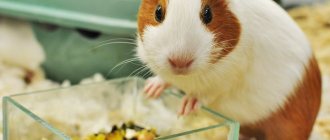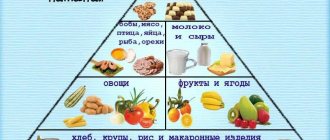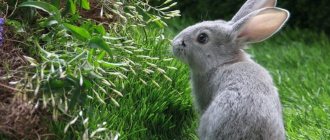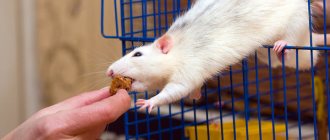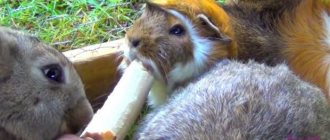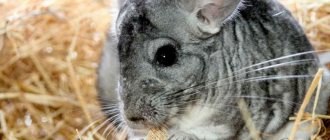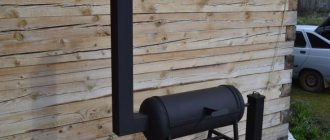Features of feeding treats
Often, the desire to pamper a chinchilla forces inexperienced owners to literally feed the animal with various treats. However, your pet’s consumption of treats must be kept under control, adhering to the following rules:
- Don't feed your chinchilla treats too often. The optimal frequency is 3-4 times a week. Eating treats more frequently will inevitably lead to obesity in your chinchilla. And as a result - to increased cholesterol, the development of heart and vascular diseases, heart attacks and strokes.
- It is advisable to offer all treats to your pet in a dried form. First of all, this concerns young animals with an unformed digestive system. Fresh fruits and vegetables can cause gastrointestinal disorders in the younger generation.
- You should feed your pet treats only after the main meal. Otherwise, over time, the fluffy will refuse regular food in favor of treats. The volume of one serving of treats should not exceed 10-12 g.
Also, some experienced chinchilla breeders recommend combining feeding with treats with training. Because the animal will learn commands much faster when reinforced with something tasty.
Is it possible to give pomegranate seeds?
The grains themselves may appeal to rats. But they should not be abused due to the increased level of acidity. A decorative rat can be given 7-10 pomegranate seeds per week.
The septum and peel have a tart taste. Many rodents don't like them. And yet there are individuals who do not mind chewing them. It should be remembered that this should not be given to rats. The composition contains tannins, which will lead to constipation in the rodent.
Decorative rat eats pomegranate
What treats can be offered from the diet?
To treat your chinchilla to something tasty, you don’t have to spend money on expensive store-bought treats. You can use some products straight from your table as treats for your fluffy. For example:
- Vegetables – carrots, cucumber, zucchini, pumpkin, tomato. Rich in fiber, therefore they have a beneficial effect on intestinal motility. For young animals up to 6-7 months of age, it is better to give vegetables only in dried form. Older animals are allowed to try fresh crops.
- Fruits are natural sources of vitamins. Chinchillas simply love the sweet fruity taste. Without compromising health, you can offer your pet an apple, pear, banana, apricot, mango, kiwi. It is also allowed to give sweet fruits such as grapes and peaches. But just a little bit at a time, in order to avoid your pet’s rapid weight gain.
- Seeds and nuts are rich in fats, minerals and fat-soluble vitamins. They are quite high in calories, so you can treat your chinchilla no more than 1-2 times a week in minimal portions, literally 4-5 g.
- Berries – contain antioxidants that prevent the development of cancer. Chinchillas will like raspberries, strawberries, currants, lingonberries, and blueberries.
- Dried crust of rye bread . This type of delicacy can be given in very limited quantities - literally 3-4 g. Moreover, crackers cannot be sprinkled with salt and other food additives.
Also, chinchillas are sometimes allowed to give dried fruits - dried apricots, prunes, figs, raisins . But not more than once a week. Before serving, dried fruits must be thoroughly washed, dried and pitted.
To avoid a negative reaction of the body to new dishes, it is recommended to introduce treats into the chinchilla’s diet gradually. For the first time, 2-3 g of a new treat will be enough. If the animal’s health has not worsened, next time the portion size can be increased.
If children live in the house, you need to carefully ensure that the kids, in an effort to please the chinchilla, do not feed it with sweets without the knowledge of the adults. Uncontrolled consumption of food can lead to illness or even death of your pet.
Is it possible to feed pomegranate to a pet rat?
The answer is clear - yes, but in small quantities. The maximum you can allow a decorative rat is a teaspoon per week. It makes sense to distribute this amount over several meals. Sour pulp, due to its high acid content and negative effect on the gastric mucosa, should be avoided. Veterinarians recommend including only sweet pomegranates in your diet.
Rat and Grant
Store-bought treats
In order not to rack your brains wondering what you can give your chinchilla and what will be harmful to it, it is better to go to a pet store and buy a specialized treat. The finished formulations are not only absolutely safe for animals, but also contain a large amount of vitamins and mineral supplements. The most popular treats for chinchillas are:
- Prestige “Fairytale House” is an edible toy in the form of a small shelter for a chinchilla. The basis of the treat is dried herbs, additional components are fruits, vegetables and a mineral supplement.
- Triol Standard for chinchillas with vegetables - a treat in the form of sticks consisting of barley, wheat, corn, sunflower, oats, with the addition of honey, carrots and beets.
- Little One - this manufacturer offers a fairly wide selection of treats for chinchillas. For example, sticks (with fruits, with herbs and flowers, with vegetables), snacks with vitamin C, mixed vegetables, herbal pads.
- JR FARM Treat for rodents Vegetable rings . The mixture contains spinach, maize, carrots, and wheat.
- Vitakraft “Mineral” rodent stone . At the same time, it is a delicacy, a source of minerals, and a stone for grinding teeth. Such a treat should always be present in the chinchilla's cage.
- TitBit tartlets with dried apple and mango . Suitable for all types of rodents, including chinchillas.
- Bins, treat "Malinka" . Contains dried leaves and whole raspberries. They have a brightening taste and are rich in vitamins.
It is worth noting that the listed treats for fluffies can be purchased at a very affordable price. The cost of treats for a chinchilla ranges from 100 to 300 rubles. At the same time, one medium package weighing 100 g will last a pet for 10-12 days.
tasty treats
Almost everyone can eat dried apples. You just need to start with a small piece so as not to irritate your stomach. The chinchilla should gradually get used to the new food. Better give us some apples. Again, it’s better to do it yourself. If you have a personal plot (dacha), that’s good. You wash your own grown apples, cut them, and then dry them slowly in the oven for several days. IMPORTANT! Dry the apples completely so that during storage they do not begin to absorb moisture and form mold.
If you buy dried apples from grandmothers near the metro, it is important to evaluate the quality of the product. Don't be lazy to look into the package. The normal appearance of dried apples is light brown or dark ocher. It is very pleasant to look at and smell, which can also tell a lot. If the smell is a little musty, it means the dried apples were stored in a plastic bag. This means that 90% of this product is not suitable for chinchillas to eat, due to the presence of mold or mildew. If the smell is fragrant and thick, and the color matches those described above, then the product is of good quality and worth taking. It is best to store it at home in cloth bags. If not, buy cotton fabric at a fabric store and sew a handbag. This will take no more than 15 minutes. It is also worth checking the product for the presence of bugs. Even if it is kept at home, the likelihood of them appearing is high. Just turn the apples with your hand. If there are bugs there, they are immediately visible. And one more thing. It is important to ask the seller where the apples were collected. If the seller’s dacha is located near major highways or a toxic waste dump, then, despite the good appearance of the product, it is highly not recommended to buy it.
How to cook it yourself
The best treat for any pet is one prepared by the owner, with care and love. A few simple recipes will help you pamper your favorite animal with homemade treats:
- Dried fruits and vegetables . The cooking method is simple. Selected ingredients (for example, apples, pears, carrots, zucchini) must be washed and cut into thin slices. Then place it on a baking sheet in one layer and put it in the oven for 15-20 minutes at a temperature of 190-200ᵒC. You can also dry the treats in a special multi-tier electric dryer. In the summer, you can dry the treats right outside, in direct sunlight. In this case, it is necessary to ensure that the fruits and vegetables are dried, but not woody.
- dry berries in the same way . For example, raspberries, hawthorn, rose hips, strawberries. Just before drying, you need to check that there are no rotten or moldy berries on the baking sheet.
- Sweet balls . To prepare, you need to mix in a deep bowl the usual food mixture that the chinchilla eats daily, seeds and pieces of fruit, berries, and dried fruits. After that, add a little honey as a binding base. The resulting adhesive mass must be formed into balls and placed in an oven preheated to 180ᵒC for 20 minutes.
- Tree branches . Chinchillas grow teeth throughout their lives. Therefore, fluffies need to constantly grind them down. For these purposes, a mineral stone is usually placed in the pet's cage. But it will be much more pleasant for the animal to sharpen its teeth on a fresh, wood-smelling twig. The preparation method is simple. Simply cut off a few side branches, clear them of leaves and wash them. Then lightly dry it in an oven or electric dryer. The pet will like twigs of apple, pear, linden, birch, and rowan.
Branches of some types of fruit trees are strictly contraindicated for chinchillas. Under no circumstances should you give your pet branches of coniferous trees, citrus trees, plums, apricots, peach, cherry, maple, bird cherry, or lilac.
It is worth keeping in mind that all dried herbs, vegetables, fruits, berries, twigs should be stored in a cool, dry place in paper bags. If storage conditions are met, the shelf life of prepared treats is 2 years. But it’s better not to wait until the deadline, but to feed the treats 2-3 months earlier.
Authorized Products
The list of foods that can be given to chinchillas is quite large. Animals can be fed fruits:
- Bananas,
- Apples,
- Pears,
- Figs
- Vegetables:
- Pumpkin,
- Milk corn,
- Bell pepper,
- Kohlrabi,
- Zucchini,
- Zucchini,
- Kohlrabi,
- Patissons,
- Ripe red tomatoes.
Roots:
- Carrot,
- Jerusalem artichoke.
Berries:
- Rose hip,
- Strawberry,
- Blueberry,
- Strawberries.
Greenery:
- Lettuce leaves,
- spinach leaves,
- Clover,
- Alfalfa,
- sorrel leaves,
- Dandelion leaves and stems,
- Celery,
- Chicory,
- Cornflowers,
- Vika,
- Common nettle,
- Sagebrush,
- Raspberry leaves and stems
- Strawberry leaves and stems
- Plant tops,
- Twigs with leaves of apple, pear,
- Birch and linden branches,
- Hazelnut sprigs.
Cereals:
- Corn (corn grains are part of the feed mixture and are given in ground form),
- Barley (given in ground form),
- Wheat (grains and bran),
- Oats (grains, bran, flakes),
- Millet,
- Buckwheat,
- Rice.
Legumes:
- Soybean,
- Peas,
- Beans,
- Red and white beans,
- Lentils.
Apples, pears, as well as carrots, pumpkins, zucchini, berries can be given to animals both fresh and dried.
Some chinchillas are more willing to eat dried foods, and they are also safer for the digestive tract.
It is recommended to collect fresh grass for furry pets in places far from roads and landfills, walking pets and industrial enterprises. It is not recommended to feed grass that is wet from dew or rain. And also carefully monitor that there are no poisonous plants among other weeds.
What not to give to a chinchilla
The digestive systems of humans and chinchillas are very different. Fluffy has a very long intestine, adapted for thorough digestion of coarse plant food. Therefore, under no circumstances should you give your pet treats that are familiar to humans. The following treats can be detrimental to the animal:
- milk and fermented milk products - kefir, cottage cheese, yogurt, yogurt, Varenets, sour cream, cheese;
- eggs;
- any mushrooms;
- any meat and meat delicacies, sausages, offal, lard;
- bread and bakery products;
- sweets - candies, chocolate, cakes, pastry cream, cakes, condensed milk, ice cream, corn sticks;
- semi-finished products and fast food;
- some vegetables - potatoes, onions, garlic, white cabbage;
- snacks – chips, crackers, salted nuts, popcorn;
- canned food;
- any drinks except pure water.
In nature, chinchillas occasionally feast on insects. Therefore, some rodent owners try to feed them dried worms or grasshoppers. It's better not to do this. Since the species composition of insects living in South America (the homeland of chinchillas) is noticeably different from the local one. Therefore, when feeding your pet local beetles and worms, the animal’s risk of developing digestive problems greatly increases.
What treats can be given to a chinchilla and how to make your own treats for your pet - every owner of the animal should know. After all, fluffies are very sensitive to the composition of their diet, and any deviation from the established recommendations can result in health problems for their four-legged friend.
Vitamin supplements to complement your diet
If the diet of chinchillas is unbalanced, young chinchillas, pregnant and lactating rodents, sick and weakened animals should be given vitamin complexes . They can be in liquid form, in the form of tablets and powders.
Liquid fortified food can be given along with water, so it will be easy to enrich your pet’s diet. It is difficult to offer powders and tablets to pets.
to hang a mineral and salt stone in the animal’s cage , which the animal will eat as needed.
You can immediately buy fortified food. The ingredients most often include carrots, pumpkin, nettle hay, rowan, and rose hips. To replenish protein and B vitamins, add a little dry yeast (2–5 g) to the feed.
Teaching a chinchilla to eat properly is not difficult , but it is absolutely necessary. Only by receiving all the useful microelements, vitamins and other beneficial compounds will the animal be healthy, full of energy and live a long life.
